Mary Cassatt The Boating Party
Artwork 14-A
Themes: Women Artists, Storytelling
Title: Weaving Tales: Transforming Visual Images into Words
Skills: Vocabulary enrichment, reading, writing, speaking, and listening
General Goals
The goal of this lesson is to acquaint students with storytelling and the artworks of Mary Cassatt. In particular, students will examine and create a story about Mary Cassatt’s The Boating Party. Students will also compare Mary Cassatt’s work with other female artists and then invent a narrative about the artist and the artwork. To achieve this aim, students will learn about and practice good storytelling techniques, will read about Mary Cassatt, and will compose and tell a story.
Specific Objectives
After this lesson, the students will be able to:
- use twelve new vocabulary items;
- understand the basic principals of successful storytelling;
- describe the composition of artworks;
- create and perform a story based on a visual analysis;
- perform a comparative analysis of different paintings (homework).
Materials/Visual Aids
- Reproduction of Mary Cassatt’s The Boating Party, 1893-1894 (either on PowerPoint or as a handout)
- Appendices A, B, C, D, E that are included with this lesson plan
Warm-up Activity: Introduction to storytelling about paintings
- Explain to the students that you are going to learn more about storytelling techniques and about the American artist Mary Cassatt. In particular, you will be looking at her painting The Boating Party.
- Entire Class Activity: Activate the students’ background knowledge by asking the following questions:
- What makes a story successful?
- Why do people like to tell and listen to stories?
- What is the difference between a visual story and an oral or written story?
- Can you think of any artworks that tell a story?
- What are some common stories that artists have depicted throughout history?
- Having finished the discussion, tell the students that you will now think about artists. Put the students in groups—assign some groups as “male artists” and others as “female artists”. Then ask the students to list as many female or male artists as possible, depending on the nature of their group. In other words, a “male artist group” will list only male artists. The “female artist group” will list only female artists. They can pick artists from any time period. Give them about two minutes to finish this task. When the students have finished, write down the names of male and female artists on the chalkboard. Briefly discuss why it was much easier to think of male artists.
- Tell the students that you will now show them three paintings created by 19th and 20th century women artists. Show the following images:
- Berthe Morisot, “Cache-Cache” (Hide and Seek) 1873
- Frida Kahlo, Self Portrait Between the Borderline of Mexico and the United States, 1932
- Mary Cassatt, The Child's Bath, 1893
You can show these images on PowerPoint or use handouts (Appendix A). Ask the students to look at each painting and write a one or two sentence summary of the plot. In other words, have them describe what is happening in the painting. Also ask them to think about the style of the painting.
- When all the images have been shown, ask for volunteers to share their impressions.
Activity 1: Vocabulary bingo and production task
- Introduce the following tweleve words to the students—these words come from the reading texts about storytelling and about Mary Cassatt.
Words

- Having reviewed the words, play vocabulary Bingo. Use the directions, game boards, and definitions in Appendix B.
- When the students have finished playing Bingo, have them do the storytelling race. Refer to the directions and worksheet in Appendix B.
Activity 2: Techniques for Telling a Good Story
- Tell the students that now that they have learned these new vocabulary items, they will be able to read a text about storytelling.
Pre-reading: to activate the students’ background knowledge, ask the following questions:
What makes a story memorable?
What makes a story boring?
Do you know any good storytellers? If so, what makes them successful?
If your friend had to come up in front of the class and tell a story, what advice would you give him or her?
- Having completed the pre-reading task, briefly preview the text. Explain to the students that the text contains advice for storytelling. Mention that there are ten tips presented in the text.
- Put the students into five groups. Tell each group that after reading the text, their group will summarize two of the tips. They will then explain these tips to the class.
- Assign two tips for each team. For example, Team 1 tips 1, 2, Team 2, tips 3, 4, etc.
- Distribute the text (Appendix C).
- When the students have finished, have them present their summaries. While they are presenting, ask the other students to write down what they say. Such an activity will reinforce the students’ listening skills and will help ensure that they are listening to their classmates. To facilitate the process, they can fill in the chart, located after the text. (Appendix C)
Activity 3: Storytelling about The Boating Party
- Having learned some tips for effective storytelling, explain to the students that they will now create and tell a story about Mary Cassatt’s painting—The Boating Party.
- Put the students in small groups. Ask the students to appoint a spokesperson for the group; the spokesperson will tell the story to the class.
- Distribute the storytelling worksheet, which is designed to help the students brainstorm. (Appendix D).
- Tell the students that they have 15-20 minutes to complete this task.
- Remind them to write down the key points so that the spokesperson can tell a memorable story.
- When the students have finished, ask the spokesperson from each group to tell their story. When all the stories have been told, have the students share their impressions.
Activity 4: Learning more about Mary Cassatt and The Boating Party
- Tell the students that now that they have created their own stories, they can see what art historians think about Mary Cassatt and her painting.
- Pre-reading: ask the students to recall the vocabulary words from the Bingo game. Tell them that they will find six of these words in the text. Ask the students the following questions about women artists:
- Do you think it was easy to be a woman artist? Why or why not?
- What issues do you think women artists faced?
- What are some differences between male and female artists?
- What are some similarities between male and female artists?
- Distribute the text from Picturing America Teachers Resource Book (pages 62-63).
- As the students are reading, draw their attention to the descriptive language used to explain Cassatt’s painting. Tell them that they will need to use this type of language for the next activity.
- When the students have finished reading, ask them to share their impressions.
Activity 5: Describing Paintings By Mary Cassatt
- Tell the students that for the final activity, they will be describing artworks. They will read their descriptions to their classmates. Then their classmates will have to guess which painting they are describing.
- Put the students in to five groups. Tell them to elect a spokesperson.
- Distribute the activity instructions and paintings (Appendix E).
Distribute the following five paintings (links are provided in Appendix E):
Breakfast in Bed
Mother and Child
Mother and Child XI
Maternal Caress
Maternal Kiss
- After reviewing the instructions, tell the students that they will have to be very precise in their descriptions because the themes of paintings are similar. Thus, one has to go beyond saying, “there is a mother with her child in the painting.”
- Remind the students not to show their painting to other groups.
- Give the students 10-15 minutes to complete this task. When they have finished, display all the paintings on the board.
- Have the spokesperson read the description. Have the other students try to guess which painting is being described.
Preparation
**If your students need art terms or practice describing a composition, you can visit the following websites for information.
- EDSITEment: Composition and Content in the Visual Arts
This site contains lesson plans about American culture.
http://edsitement.neh.gov/view_lesson_plan.asp?id=647
This website contains a list of useful terms for describing and analyzing artworks.
http://www.khsd.k12.ca.us/bhs/Perry/art%20vocabulary.htm
In addition to art terms, this website contains useful links to museums.
http://www.martinlawrence.com/glossary_explore.html
Homework
Have the students find an artwork created by a female artist and write a story about the painting.
Alternatively, the students could write a comparative analysis of one of Mary Cassatt’s paintings with her contemporary Berthe Morisot.
Extensions
1. Have the students examine different women artists. They can examine the different issues women artists have faced throughout the ages. Such an investigation could result in an oral or written production. For a list of women artists throughout the ages, you can visit the following website: Women Artists In History http://www.wendy.com/women/artists.html
2. Many female artists were either married to or had relationships with male artists. Examples of this phenomenon include: Camille Claudel and Rodin, Jackson Pollock and Lee Krasner, and Willem and Elaine de Kooning. The students might examine if their relationship influenced their artworks. Or how they influenced each other artistically.
References
Art Term Glossary
http://www.khsd.k12.ca.us/bhs/Perry/art%20vocabulary.htm
Art Terms
http://www.martinlawrence.com/glossary_explore.html
Berthe Morisot
http://www.ibiblio.org/wm/paint/auth/morisot/
EDSITEment
http://edsitement.neh.gov/view_lesson_plan.asp?id=647
Frida Khalo
http://mati.eas.asu.edu:8421/ChicanArte/html_pages/kahlo5.lrgest.html
Mary Cassatt
http://www.artic.edu/aic/collections/artwork/111442
http://www.marycassatt.org/home-2-24-1-0.html
Old Fashioned Living
http://oldfashionedliving.com/storytelling.html
Women Artists In History
http://www.wendy.com/women/artists.html
Appendix A
Image 1:
Berthe Morisot,
“Cache-Cache” (Hide and Seek)
1873, Oil on canvas, 45 x 55 cm (17 3/4 x 21 5/8"); Collection Mrs. John Hay Whitney, New York
The models are Berthe Morisot's sister Edma and Edma's daughter Jeanne.
Image 2:
Frida Kahlo
Self Portrait Between the Borderline of Mexico and the United States
1932, oil painting on tin, 11 3/4" X 13 1/2"; Collection of Mr. and Mrs. Manuel Reyero
- This image can be found at:
http://mati.eas.asu.edu:8421/ChicanArte/html_pages/kahlo5.lrgest.html
Image 3:
Mary Cassatt
The Child's Bath,
1893, Oil on canvas, 100.3 x 66.1 cm (39 1/2 x 26 in. );
Art Institute of Chicago
Robert A. Waller Fund, 1910.2

Overview:
The purpose of this activity is to help reinforce students’ knowledge of new vocabulary items. The objectives of this activity are listed below. After completing this activity:
- Students should be able to match definitions with words.
- Students should be able to use the new vocabulary words productively.
Materials:
- Bingo Cards (Attached)
- 6 Game Cards (Attached)
- Game chips (can use candy, stickers, game chips, small pieces of paper)
- List of Vocabulary Words and Definitions
- Storytelling Race Worksheet
Directions
- Introduce the following words to the students: impact, barren, provocative, prowl, anecdote, nurture, defy, fleeting, saturated, equilibrium, rendition, invariably.
- Put the students in small groups.
- Start the game.
- When you have finished Bingo, begin the storytelling race.

Bingo Game
Read the Bingo Directions to the students (p. 2).
Distribute the game cards and chips.
Begin selecting and reading the definitions of the vocabulary words
Storytelling Race
Read the Storytelling Race Directions to the students (p. 2)
Distribute the worksheets.
Correct the answers when the students have finished.
Announce the winners.

Bingo Directions
Each team will get a game card. On each game card there are eight vocabulary words. The teacher picks a definition and the students see if they have the corresponding word. If the word matches the definition, put a game chip on the sentence. If not, wait until the next definition is read. When all your words have been covered, yell bingo! If you have correctly identified the words, your team will have won round one of the game.

Sentence Correction Race Directions
For this part of the game, you will need to create a story using all eight of the vocabulary words on your card. The team that is able to correctly use as many words as possible in 7- minutes is the winner!
Total Points
Bingo Winner 10 points
Storytelling Race 10 points
Total 20 points
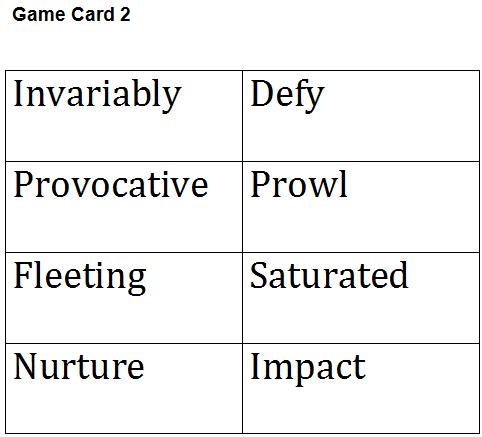
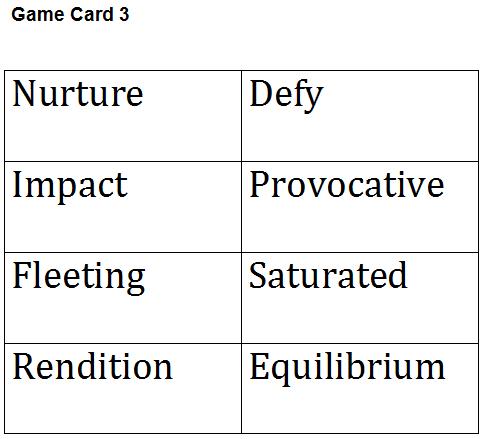
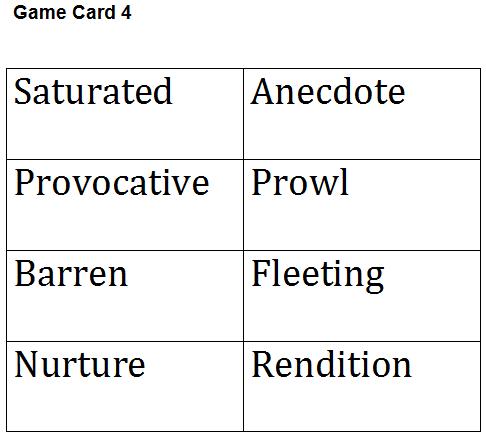
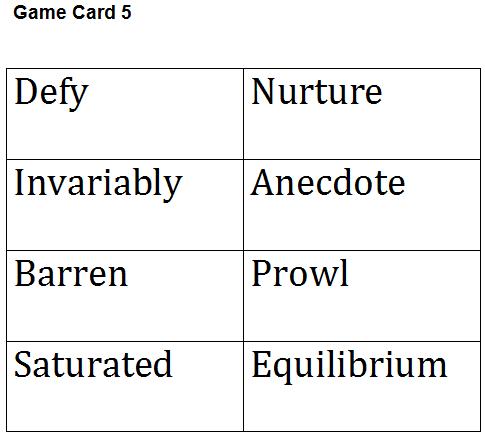
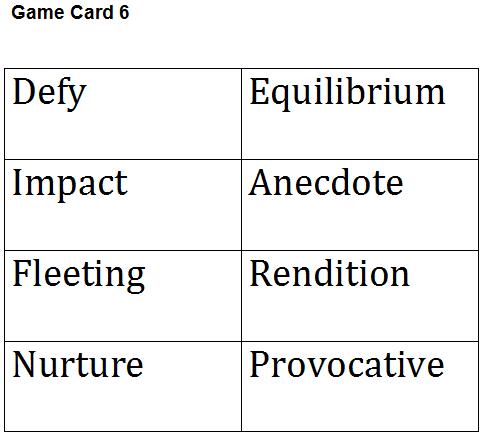
Appendix B (cont.)
Vocabulary List and Definitions
Anecdote—noun, a short and interesting true story
Barren—adjective, land that is unable to produce and vegetation, empty or desert
Defy (Defying)—verb, (trans.), to resist or disobey, to do or say something
Unbelievable
Equilibrium—noun, a situation where opposing forces are balanced; a peaceful state of mind
Fleeting—adjective, lasting for--r a very short time
Impact—noun an impression, the influence or effect of something on someone
Invariably—adverb, on all occasions, always
Nurture—verb (trans.), to care for, to encourage to grow
Provocative—adjective, causing a strong reaction
Prowl—verb (trans), to move around in a stealthy manner like a hunter
Rendition—noun, a visual reproduction; a performance or interpretation--a
Saturated—adjective, holding a large amount of water, soaked; (of color) extremely bright—no mixture of white
Appendix B (cont.)
Vocabulary Storytelling Worksheet
Use words to paint an image!
Overview
Now that you have finished the Bingo game, you can now begin to practice using the new words you learned.
Directions
- Review the words on your bingo game board.
- Think of a story that allows you to use as many of the words as possible.
- Write you story below.
- Present the story to the class.
Time
Your team will only have 7 minutes to complete this task, so work fast!
Story
Appendix C
The Top 10 Tips on Storytelling and Making an Impact
By Dr. Clare Albright
All great communicators are great storytellers. Listeners are more open to receiving when they hear the message delivered in a story format - they can lower their walls and defenses because the message is coming to them in a safe and indirect way. Wherever you want to make an impact, tell a story!
1. Paint images with your words by describing things using words related to the five senses. "The day that my grandmother died the world looked like a barren place to me. Everything looked brown and vacant."
2. Use concrete words from the physical world when speaking, even when talking about invisible things. For example, an audience would be more touched by the very real image of 'crying' than the more abstract words 'mourn' or 'grieve.' "I cried on and off for several months after my grandfather passed away' versus, "I mourned and grieved for four months when my grandfather passed away."
3. Create suspense by starting out with a provocative sentence or a provocative question. Finish up by delivering the resolution to your original provocative question. For instance, "Do you know what the one thing is that all women hate? Years ago, I met a female police officer who... And that's how I learned that the one thing that all women hate is...."
4. Use words that 'sing.' This would include words that inspire, words that imitate a sound, words that paint a beautiful picture, etc. Become an investigator on the prowl to find more words that have this kind of effect. Examples: sanctuary, crescendo, seaside, etc.
5. Tell stories when extra emphasis is needed. Your listeners will remember the story long after they remember anything else that you may have shared.
6. Use scenes from movies to drive home a point that you are trying to make. For example, you could say, "When she found out how much credit card debt I am in, I felt like the Wizard of Oz when they pulled back the curtain and revealed the little old man."
7. Take note of which anecdotes have a powerful impact on others. Reuse these anecdotes whenever possible. This type of anecdote will either move an audience to tears or move listeners enough to make them talk about the anecdote later on with you. Why keep a valuable tool in a drawer?
8. Limit the use of personal anecdotes when making a public presentation. If you use more than three or four stories about your own life, your listeners may feel that you are taking more (their time, attention, etc.) from them than you are giving to them.
9. Tell stories about the cute things that your children and animals have done recently. These anecdotes will brighten up your listeners' day and warm their hearts!
10. Practice your storytelling skills on a daily basis. People will feel nurtured, entertained, and supported by your effort to become a good storyteller.
Taken From: Old Fashioned Living
http://oldfashionedliving.com/storytelling.html
Summary of Tips
Tip 1: Tip 8:
Tip 2: Tip 9:
Tip 3: Tip 10:
Tip 4:
Tip 5:
Tip 6:
Tip 7:
Appendix D
The Boating Party
By Mary Cassatt
Telling a Story
Overview
The purpose of this worksheet is to help you create a story about Mary Cassatt’s painting, The Boating Party. Answering these questions will help you develop the characters and the plot. If you already have a story in mind, then you can skip the brainstorming stage and begin writing your story.
Directions
- To help you get started with your story, answer the following questions.
- Write down the key points of your story.
- Tell the story to the class.
Questions
Characters
Who is the lady in the painting? Is she the mother of that child? How does she look?
What social class do you think she belongs to? How is she dressed?
Who is the baby? Is she happy? How old do you think she is? Does she look comfortable?
Who is the man in the painting? Why is he wearing all black? How does he look?
What social class do you think he belongs to?
Relationships Between Characters
Do the man and woman know each other? Are they married? Is it their baby?
Are they strangers? Does the baby belong to the woman?
Plot
Where are they going? Is this really a boating party? If so, what kind of party is this?
Why is the lady wearing pink? Why did the lady take the baby on the boat? Are the characters having fun? What is the weather like? Are they heading to the shore? If so, what will they do when they reach land? Did the lady pay for this boat trip?
Appendix E
Mary Cassatt
Describing What You See
Overview
The purpose of this activity is to help you practice using descriptive language. In addition, this activity will allow you to learn more about Mary Cassatt’s artistic production.
Directions
- Get in to groups.
- Elect a spokesperson to read the group’s description.
- Get a Mary Cassatt painting. Don’t show your painting to any other group.
- Look at the painting and analyze the details.
- Write a detailed description of the painting.
- When all the groups have finished, send your spokesperson to the front of the class to read the description.
- Listen to the other groups’ descriptions and try to guess which painting they wrote about.
** Note: all the paintings have a similar theme. Thus, you will need to be very precise about describing your painting.
Description
Appendix E (cont.)
Mary Cassatt Paintings
All the Mary Cassatt Paintings can be found at the following website.
http://www.marycassatt.org/home-2-24-1-0.html
Below you will also find the specific links to the five paintings needed for the activity.
1. Mary Cassatt
Breakfast in Bed
http://www.marycassatt.org/Breakfast-in-Bed.html
2. Mary Cassatt
Mother and Child
http://www.marycassatt.org/Mother-And-Child.html
3. Mary Cassatt
Mother and Child XI
http://www.marycassatt.org/Mother-And-Child-XI.html
4. Mary Cassatt
Maternal Caress
http://www.marycassatt.org/Maternal-Caress.html
5. Mary Cassatt
Maternal Kiss
|

